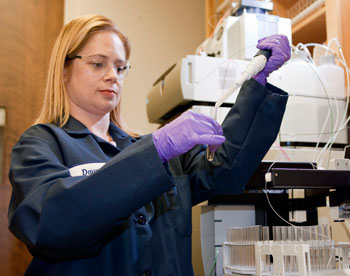Dawn Shaughnessy and her team at the Heavy Element group are working to make chemistry class even harder.
There is no element named after her (yet), but Dawn Shaughnessy—a relatively young chemist at Lawrence Livermore National Laboratory—is one of the more prolific researchers in the small world of scientists who seek to create entirely new entries to the periodic table that most of us learned about in grade school.
 The team she leads, the Heavy Element Group, was part of the discovery of three out of the four new elements announced last week in collaboration with researchers in Russia and Tennessee. In total, she’s helped discover 6 of the 26 new elements added since 1940 (one, Livermorium, was named after her lab).
The team she leads, the Heavy Element Group, was part of the discovery of three out of the four new elements announced last week in collaboration with researchers in Russia and Tennessee. In total, she’s helped discover 6 of the 26 new elements added since 1940 (one, Livermorium, was named after her lab).
In an AMA on Reddit, she talked about how she became a scientist and where some of the current limits of science need to be stretched in order for new discoveries to continue in her field.
Shaughnessy once wanted to become a doctor or surgeon, but by the time she got to middle school, she became interested in science. By high school, she realized chemistry was her calling. She hopes more kids consider her path: “I think that too few are getting the opportunity to learn about the world around them.”
Her days are varied but clearly never boring. Sometimes she works at the National Ignition Facility, home to the largest laser beam in the world. Other days, she might be at the lab. “The theory drives the experiments,” she says. “Since these are long experiments, they are scheduled for a set amount of beam time that may last several months. Then there is an equal amount of time spent analyzing the huge data set that is generated and evaluating the results.”
Video: A short clip of Dawn Shaughnessy in which she talks about the important roles women play in new scientific discoveries, and how this inspires future generations of young women.
Uranium (atomic number 92) is the heaviest element stable enough to be found in nature. The new elements discovered recently were much heavier and unstable (numbers 115, 117, 118—the heaviest to date), which means they exist for only the smallest fraction of a second before breaking down into smaller parts. Typically, her experiments produce maybe 1 to 3 highly-unstable new atoms, if they are successful. They are made by formulating “target” atom and then smashing it with a beam of other atoms so that there’s a very small chance they combine to form a new element.
“It is getting more difficult to go up in atomic number because of the probability of these nuclei holding together for long enough to for us to detect them is getting smaller and smaller,” she says. “We also need to look into alternate reactions for creating them, such as new beam and target materials. So we are still pushing for new discoveries, but there is research to be done in how to accomplish them.”
Though others are already looking to push to create elements 119 and 120, her main focus for now is actually trying to create the tools so they can study the chemical properties of some of the lighter “superheavy” elements that have been created. The problem is that there are no instruments in existence that can operate as quickly as one-second time scales needed to measure the new elements.
For me, it’s really tangible that another generation of young women can look at [the periodic table of elements] and say, “Here’s a woman that did something, very successful, and I can look at it in my text book and study about it.” And that it for me my proudest accomplishment.” –Dawn Shaughnessy
As for why anyone would care to produce elements that aren’t very useful, exist only for a few seconds, and can’t even be studied, she speaks about the broader quest to understand the world around us.
“The interest in discovering new elements is to refine our theories about the existence of matter and how the nucleus is formed,” she writes. “Every time we push the boundary of finding a new element, it helps to refine these models and our basic understanding of the extreme limits of matter.”
Dawn is the group leader for experimental nuclear and radiochemistry and the principal investigator for the heavy element group at Lawrence Livermore National Laboratory. Under her leadership, a team of scientists has discovered six new elements on the periodic table – the heaviest elements found to date. She recently led a group that named the newest heavy element to be accepted into the periodic table – Livermorium – in honor of the Lab and its host city of Livermore. In addition to her research, Dawn thrives on getting young people interested in science. Her team received a $5,000 grant and donated it to the Livermore High School chemistry department. The gift grew from Dawn’s memories of working in poorly equipped chemistry classes in high school. In 2012 she was inducted into the Alameda County’s Women’s Hall of Fame.
Source: FastCoExist.com
